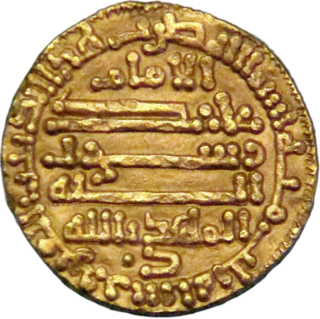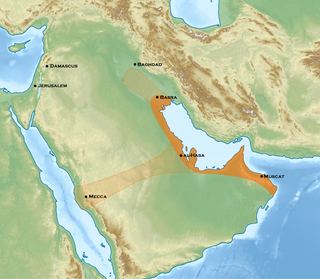Related Research Articles
The Fatimid dynasty was an Arab dynasty that ruled the Fatimid Caliphate, between 909 and 1171 CE. Claiming to be descended from Fatima and Ali and adhering to Isma'ili Shi'ism, they held the Isma'ili imamate and considered themselves the rightful leaders of the Muslim community. The line of Nizari Isma'ili imams, represented today by the Aga Khans, claims descent from a branch of the Fatimids. The Alavi Bohras, predominantly based in Vadodara, also claim descent from the Fatimids.

Abū Muḥammad ʿAbd Allāh ibn al-Ḥusayn, better known by his regnal name al-Mahdī biʾllāh, was the founder of the Isma'ili Fatimid Caliphate, the only major Shi'a caliphate in Islamic history, and the eleventh Imam of the Isma'ili branch of Shi'ism.

Abū Muḥammad ʿAlī ibn Aḥmad ibn Ṭalḥa ibn Jaʿfar ibn Muḥammad ibn Hārūn al-Muktafī bi'Llāh, better known by his regnal name al-Muktafī bi-Llāh, was the caliph of the Abbasid Caliphate from 902 to 908. More liberal and sedentary than his militaristic father al-Mu'tadid, al-Muktafi essentially continued his policies, although most of the actual conduct of government was left to his viziers and officials. His reign saw the defeat of the Qarmatians of the Syrian Desert, and the reincorporation of Egypt and the parts of Syria ruled by the Tulunid dynasty. The war with the Byzantine Empire continued with alternating success, although the Arabs scored a major victory in the Sack of Thessalonica in 904. His death in 908 opened the way for the installation of a weak ruler, al-Muqtadir, by the palace bureaucracy, and began the terminal decline of the Abbasid Caliphate that ended in 946 with the caliphs becoming puppet rulers under the Buyid dynasty.
Abū Bakr Muḥammad ibn Ṭughj ibn Juff ibn Yiltakīn ibn Fūrān ibn Fūrī ibn Khāqān, better known by the title al-Ikhshīd after 939, was an Abbasid commander and governor who became the autonomous ruler of Egypt and parts of Syria (Levant) from 935 until his death in 946. He was the founder of the Ikhshidid dynasty, which ruled the region until the Fatimid conquest of 969.
Husayn ibn Hamdan ibn Hamdun ibn al-Harith al-Taghlibi was an early member of the Hamdanid family, who distinguished himself as a general for the Abbasid Caliphate and played a major role in the Hamdanids' rise to power among the Arab tribes in the Jazira.
The Battle of Hama was fought some 24 km (15 mi) from the city of Hama in Syria on 29 November 903 between the forces of the Abbasid Caliphate and pro-Isma'ili Bedouin. The Abbasids were victorious, resulting in the capture and execution of the Isma'ili leadership. This removed the Isma'ili presence in northern Syria, and was followed by the suppression of another revolt in Iraq in 906. More importantly, it paved the way for the Abbasid attack on the autonomous Tulunid dynasty and the reincorporation of the Tulunid domains in southern Syria and Egypt into the Abbasid Caliphate.
Muhammad ibn Ishaq ibn Kundaj was a prominent general of the Abbasid Caliphate in the early 10th century.
Abu Bakr Muhammad ibn Ali al-Madhara'i (871–957) was the last important representative of the bureaucratic al-Madhara'i dynasty of fiscal officials. He served as director of finances of Egypt and Syria under the Tulunid dynasty and the Abbasid Caliphate, as well as becoming vizier for the Tulunid ruler Harun ibn Khumarawayh, and later occupying high office under the Ikhshidids.
Ṭughj ibn Juff ibn Yiltakīn ibn Fūrān ibn Fūrī ibn Khāqān was a Turkic military officer who served the Abbasid Caliphate and the autonomous Tulunids. He was the father of Muhammad al-Ikhshid, the founder of the Ikhshidid dynasty.
Ahmad ibn Kayghalagh was an Abbasid military officer of Turkic origin who served as governor in Syria and Egypt. He was ousted as governor of Egypt by Muhammad ibn Tughj in 935.
Muhammad ibn Sulayman, surnamed al-Katib, was a senior official and commander of the Abbasid Caliphate, most notable for his victories against the Qarmatians and for his reconquest of Syria and Egypt from the autonomous Tulunid dynasty.
Yahya ibn Zakarawayh, also known under his assumed name Sahib al-Naqa, was a Qarmatian leader in the Syrian Desert in the early years of the 10th century.
Badr ibn ʿAbdallāh al-Ḥammāmī also known as Badr al-Kabīr, was a general who served the Tulunids and later the Abbasids.
Hamdan Qarmat ibn al-Ash'ath was the eponymous founder of the Qarmatian sect of Isma'ilism. Originally the chief Isma'ili missionary in lower Iraq, in 899 he quarreled with the movement's leadership at Salamiya after it was taken over by Sa'id ibn al-Husayn, and with his followers broke off from them. Hamdan then disappeared, but his followers continued in existence in the Syrian Desert and al-Bahrayn for several decades.
Zakarawayh ibn Mihrawayh, often misspelled as Zikrawayh in modern sources, was an Isma'ili and Qarmatian leader in Iraq who led a series of revolts against the Abbasid Caliphate in the 900s, until his defeat and death in January 907.
The First Qarmatian invasion of Egypt took place in 971, when the Qarmatians of Bahrayn unsuccessfully invaded Egypt, which had recently been conquered by the Fatimid Caliphate. Both the Qarmatians and the Fatimids were offshoots of the Isma'ili sect of Shi'a Islam, but belonged to different and rival branches. Following the takeover of Egypt under the general Jawhar in 969, the Fatimids began their expansion into the Levant. There they confronted the Qarmatians, who in previous years had raided and extracted tribute from the regional potentates. In order to stop the Fatimid advance, the Qarmatians, led by al-Hasan al-A'sam, joined in a league with other regional powers, including the Sunni Abbasid caliph in Baghdad. After defeating and killing the Fatimid commander Ja'far ibn Fallah at Damascus in August 971, the Qarmatians and their Bedouin allies marched south. A Fatimid relief army marching to assist Ibn Fallah withdrew to Jaffa where it was blockaded, while the main Qarmatian army invaded Egypt. The diversion of the Qarmatian forces into the Nile Delta in support of local revolts gave Jawhar the time to mobilize his remaining forces and prepare defences in the form of a trench and wall at Ayn Shams, just north of Cairo, then still under construction as the new Fatimid capital. At a battle north of the city on 22 and 24 December, Jawhar defeated the Qarmatians and forced them to withdraw from Egypt in disorder. After the Qarmatians quarreled with their Bedouin allies, the Fatimids were able to reoccupy Ramla, but this was short-lived; by the summer of 972, Palestine was again under Qarmatian control. On the other hand, the rebellions in Egypt were suppressed, and the Fatimid caliph al-Mu'izz was able to move his capital from Ifriqiya to Cairo in June 973. A second invasion followed in 974, which was also defeated, ending the Qarmatian threat for good, and paving the way for the Fatimid expansion into the Levant.

The Sack of Mecca occurred on 11 January 930, when the Qarmatians of Bahrayn sacked the Muslim holy city amidst the rituals of the Hajj pilgrimage.
Abu'l-Qāsim al-Ḥasan ibn Faraj ibn Ḥawshab ibn Zādān al-Najjār al-Kūfī, better known simply as Ibn Ḥawshab, or by his honorific of Manṣūr al-Yaman, was a senior Isma'ili missionary from the environs of Kufa. In cooperation with Ali ibn al-Fadl al-Jayshani, he established the Isma'ili creed in Yemen and conquered much of that country in the 890s and 900s in the name of the Isma'ili imam, Abdallah al-Mahdi, who at the time was still in hiding. After al-Mahdi proclaimed himself publicly in Ifriqiya in 909 and established the Fatimid Caliphate, Ibn al-Fadl turned against him and forced Ibn Hawshab to a subordinate position. Ibn Hawshab's life is known from an autobiography he wrote, while later Isma'ili tradition ascribes two theological treatises to him.
The Qarmatian invasion of Iraq was a large-scale raid by the Qarmatians of Bahrayn against the Abbasid Caliphate's metropolitan region of Iraq, that began in autumn of 927 and continued until the summer of 928.
References
- ↑ Brett 2001, p. 65.
- ↑ Kennedy 2004, pp. 286–287.
- ↑ Kennedy 2004, p. 286.
- ↑ Brett 2001, pp. 65–66.
- ↑ Rosenthal 1985, pp. 135–144.
- ↑ Rosenthal 1985, pp. 158–168.
- ↑ Kennedy 2004, pp. 185, 286.
- ↑ Brett 2001, p. 66.